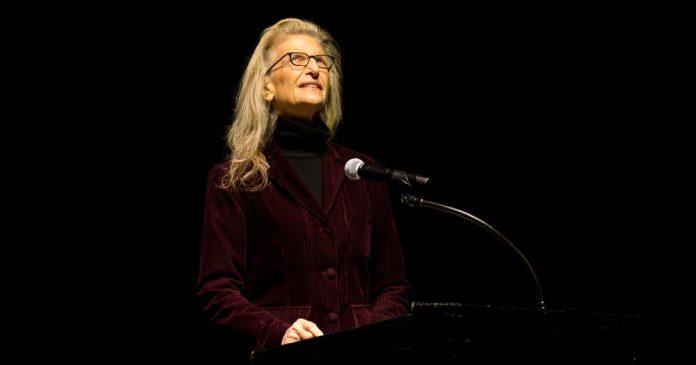On the Shelf
Annie Leibovitz: Women
By Annie Leibovitz with essays by Chimamanda Ngozi Adichie, Susan Sontag and Gloria Steinem
Phaidon Press: 493 pages, $100
If you buy books linked on our site, The Times may earn a commission from Bookshop.org, whose fees support independent bookstores.
Annie Leibovitz strides onto the Wiltern stage to the thunderous cheers of 1,500 mostly female fans. She takes her place at the podium, a small, casually dressed figure on a big stage. On the screen behind her are images of the matching covers of her new two-book set, “Annie Leibovitz: Women.” Volume 1 is her 1999 collection. Volume 2 has 100 new photos captured in the 25 years since. Taken together, the slipcased set zooms in on the past quarter century of American womankind, rendered in 250 images of dancers, actors, astronauts, artists, politicians, farmers, writers, CEOs, philanthropists, soldiers, musicians, athletes, socialites and scientists.
“The book was Susan’s idea,” Leibovitz says on Tuesday, referring to writer Susan Sontag, her partner until Sontag’s death in 2004. “I thought doing a photo book about women was a bad idea, like going out and photographing the ocean. But then I heard what Hillary Clinton said at the U.N. Conference on Women in 1995 — ‘Women’s rights are human rights, and human rights are women’s rights’ — and I reconsidered.” Applause shakes the Wiltern rafters.
An image from Volume 2 appears, featuring a somber-looking Sontag. “This is the last formal portrait of Susan,” Leibovitz says. “You could think she’s projecting a sense of strength, but really, she was mad at me for making her go outside to take the picture.” The crowd roars with laughter.
Think of Leibovitz, and some legendary photographs spring to mind. Whoopi Goldberg submerged in a milk-filled bathtub on the cover of Vanity Fair, July 1984. Also on VF covers: Michael Jackson, fittingly clothed and shot in black-and-white, in 1989. Demi Moore, fully pregnant and fully naked, two years later. But the photo that remains Leibovitz’s most iconic to date is the January 1981 cover of Rolling Stone featuring a nude, fetal John Lennon wrapped around Yoko Ono. “John showed up naked,” Leibovitz tells the audience. “Yoko wanted to wear clothes, so she’s fully dressed.” Leibovitz took the Polaroid on Dec. 8, 1980 — a few steps away from, and a few hours before, Lennon was shot and killed by former fan Mark David Chapman.

Joan Baez in Woodside, Calif., in 2007, from “Annie Leibovitz: Women.”
(Annie Leibovitz)
In Volume 2, we find a barefoot Joan Baez sitting in a tree strumming her guitar; a pregnant Rihanna draped in jewels and fur; Billie Eilish dreaming over a journal with pencil in hand; Shonda Rhimes with her feet up on a desk as massive as her oeuvre; and an uninhibited Michelle Obama as we’ve never seen her before: chin raised, eyes closed, hair tossed back, T-shirt and jeans parted to reveal her midriff. “I was in shock,” Leibovitz says. “But the first lady’s assistant was standing next to me, shouting, ‘That’s my first lady!’”
Familiar faces dominate, but woven between them are portraits of “regular” American women. A botanist precedes Oprah Winfrey, a philanthropist and a rabbi surround the founder of a Skid Row nonprofit, the reproductive rights activists of Moms Demand Action share space with a nude Lady Gaga. “I told her to bring a slip,” Leibovitz comments. “I’d rather people keep their clothes on at this point in my life.”
Volume 2 includes one essay each from activist Gloria Steinem, Nigerian writer Chimamanda Ngozi Adichie and Leibovitz herself. Steinem writes, “This book will help us to discover our adventurous true selves. … We are atoms whirling in place, affected by and affecting those near and far from where we are.”
Adichie agrees. “Taken as a whole,” she writes, “these photographs create a deeply moving experience, they refute the singular lens, they revel in plurality’s power, and because of — or perhaps in spite of — their wide range, they are infused with a spirit that is communal, collective, even unifying — and ultimately hopeful.”

Leibovitz concludes the second book. “For this volume I thought about issues that are important today,” she writes. In 2016, when she was beginning work on Volume 2, the notoriously cloistered Leibovitz told a New York Times reporter about the nationwide “talking circles” she and Steinem had organized, in which women shared their experiences with issues including sexual violence, technology and human rights. “Talking in groups like that, it brings me to tears,” Leibovitz told the reporter, adding that the new work she was making for Volume 2 was more “democratic.” Volume 2 is indeed more diverse, possibly in response to a widely discussed critique of Leibovitz’s photographs of Black women.
No celebrity survives fame without acquiring a layer or two of tarnish. In the decades between Volumes 1 and 2, Leibovitz’s representations of Black women painted Leibovitz with hers. A 2022 Guardian story was headlined, “Annie Leibovitz proves yet again: she can’t photograph Black women.”
“Leibovitz’s photographs are what happens when Blackness is seen through a white gaze incapable of capturing its true beauty,” contributor Tayo Bero wrote, referring to a list of Leibovitz subjects including Simone Biles, Viola Davis, Serena Williams and Rihanna. Bero wrote, “In all cases, she manages to make her subjects look dull, ashy, pained and sad, a far cry from the lively and graceful people that they usually are.”
Bero and others particularly criticized an image Leibovitz made for Vogue, depicting Supreme Court Justice Ketanji Brown Jackson at the Lincoln Memorial. In the photo, the snow-white marble statue takes center stage, overlooking Brown Jackson on the lower left. At the Wiltern, when that image appears, Leibovitz speaks of her own experience shooting it, not the controversy surrounding its publication. “I was skeptical about that idea,” Leibovitz says. “But she walked into the rotunda and she started reading Lincoln’s words that are engraved into the wall. It was such a moving moment.”
Two years later, the controversy was reawakened by Leibovitz’s depictions of Zendaya, also in Vogue. An April 2024 piece on the website Screenshot Media reiterated the photos’ failure to accurately reflect “the beauty of melanated skin tones, with poor lighting that often results in lackluster portrayals.”
In her introductory essay to Volume 2, Adichie, on the other hand, praises Leibovitz’s sensitivity. “The first time Annie photographed me, more than ten years ago at my home, she sensed my discomfort right away and knew it was not merely about my general awkwardness with being photographed. It was specifically about my belly, which was newly postpartum, although I would probably still have worried even if it wasn’t. … Annie’s sanguine reaction was a relief. There was no divisiveness, no judgment.”

Rihanna at the Ritz Hotel, Paris, in 2022, from “Annie Leibovitz: Women.”
(Annie Leibovitz)
Leibovitz, her representatives and her publisher, Phaidon Press, declined to comment on the critique. In an email interview with Phaidon Vice President Deborah Aaronson, who worked on four Leibovitz titles, Aaronson said, “‘Women’ reaffirms Annie Leibovitz’s place in the photographic canon. In the ‘Women’ series, she captures a breadth of experience and people who live and work in different spheres that’s unparallelled. I believe the series makes her the most important chronicler of women over the past 50 years.”
Annie Leibovitz entered the San Francisco Art Institute at 22, intending to be a painter. But a night photography class she took on a whim changed her medium, and her life. While still a student, manifesting the confidence that would characterize her career, Leibovitz pitched a Lennon shoot to Rolling Stone. Three years later, rendered immortal as the final photographer of Lennon and Ono, Leibovitz became Rolling Stone’s chief photographer.
In 1983, Leibovitz joined the staff of Vanity Fair, where her field of exploration, and her social sphere, expanded to include actors, athletes and politicians. In 1991, she became the first woman to have a solo show at the National Portrait Gallery in Washington, D.C. She was designated a Library of Congress Living Legend in 2000.
In 2001, at age 52, Leibovitz gave birth to her first daughter, Sarah Cameron Leibovitz. Sontag was at her bedside. In May 2005, via surrogate, Leibovitz became the mother of twin daughters, Susan (named for her beloved painter sister) and Samuelle. In 2009, Leibovitz was commissioned to make the official portrait of the first family — President Barack Obama; his wife, Michelle; and their daughters, Sasha and Malia — continuing the relationship that began in 2004 when she photographed Obama in his run for the U.S. Senate.
“I want to photograph the White House,” Leibovitz says, “but I don’t think there will be much of it left when I get to it.” The evening ended as it began: with the enthusiastic applause of her audience.







